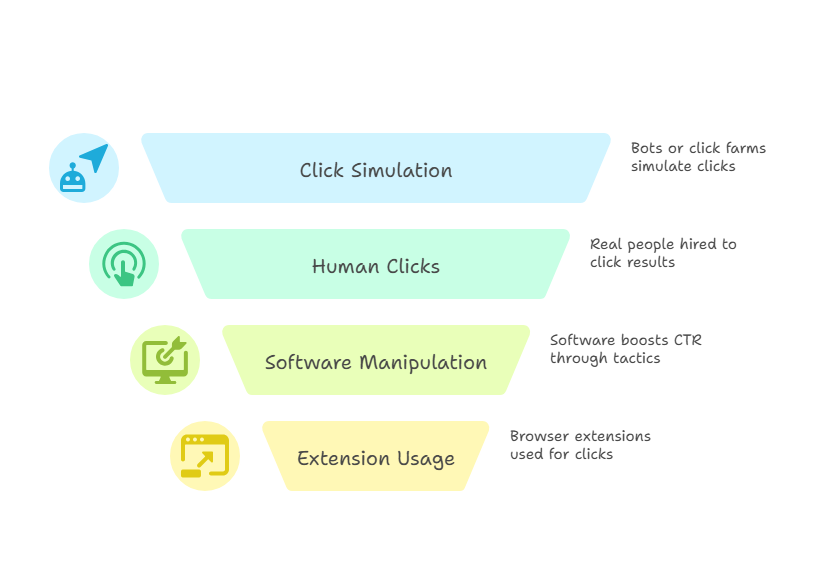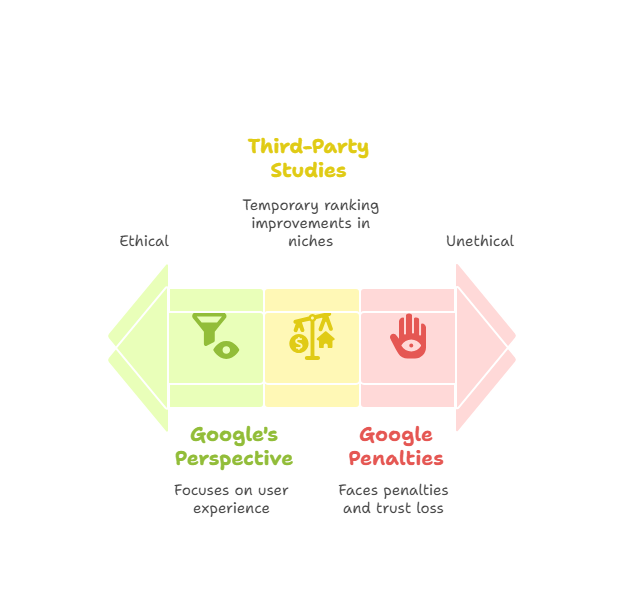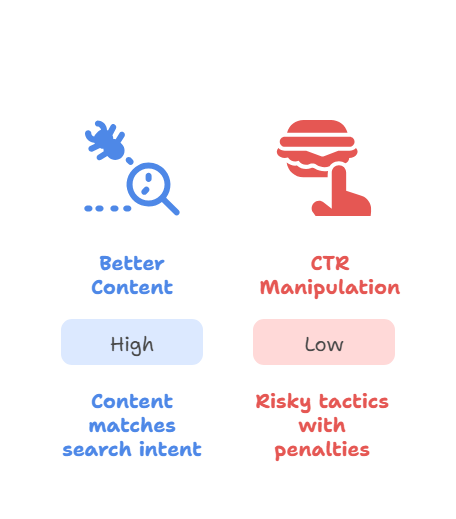Imagine publishing what you believe is the perfect blog post. It’s well-researched, expertly written, and addresses exactly what your audience is searching for. Yet it remains stuck on page two of Google, receiving barely any clicks while mediocre content ranks above you.
This frustrating scenario leads many to consider CTR manipulation—the controversial practice of artificially boosting click-through rates to potentially improve search rankings. Before exploring this risky territory, let’s examine what CTR manipulation actually involves, how it operates, and most importantly, whether it’s worth the potential consequences.
The answer might challenge your assumptions about quick SEO fixes.
What Is CTR Manipulation?
Click-through rate (CTR) represents the percentage of people who click on your website after seeing it in search results. If 100 people view your listing in Google and 5 click through, you achieve a 5% CTR.
CTR manipulation involves artificially inflating this percentage through various deceptive tactics. Rather than waiting for genuine users to naturally discover and engage with your content, you’re essentially gaming the system to create an illusion of popularity.
Think of it as purchasing fake social media followers, but applied to search results. You’re manufacturing false engagement signals hoping search engines will reward you with improved rankings.
Why CTR Matters in SEO
While Google has never officially confirmed CTR as a direct ranking factor, many SEO professionals believe it functions as a user engagement signal in the algorithm.
The reasoning seems logical: when numerous people click your result upon seeing it in search, this suggests your content provides relevance and value. Since Google prioritizes showing users the most helpful results, a high CTR could indicate your page deserves higher rankings.
However, there’s a crucial caveat—Google actively monitors for CTR manipulation. Many experts believe that even if CTR influences rankings, it likely carries minimal weight in Google’s sophisticated algorithm. The search engine has developed advanced methods for detecting artificial engagement signals.
Despite this awareness, some SEO practitioners continue experimenting with CTR manipulation after observing temporary ranking improvements, keeping this controversial practice alive in certain corners of the SEO community.

How CTR Manipulation Works
Common Tactics (Hint: Some Are Risky)
Understanding how people manipulate CTR reveals the sophistication and risks involved. Most of these methods violate Google’s terms of service and can result in severe penalties:
- Using bots or click farms to simulate clicks: Automated software performs searches and clicks on specific results. These bots can mimic human behavior by varying click patterns and spending different amounts of time on pages.
- Hiring real people to click search results: Platforms like Amazon Mechanical Turk or specialized services employ actual humans to perform searches and click targeted results. This method proves harder for Google to detect since it involves real people.
- CTR manipulation software or services: Dedicated tools and services promise CTR boosts through various means. These often combine multiple tactics while rotating IP addresses and user agents to appear more natural.
- Browser extensions and geo-targeted scripts: Some services utilize browser extensions installed on real users’ computers, or employ scripts targeting clicks from specific geographic locations to make traffic appear legitimate.
Modern CTR manipulation has become increasingly sophisticated, attempting to mimic natural user behavior through varied click timing, different devices and browsers, and realistic user journey simulations through websites.
Real vs. Artificial CTR: What’s the Difference?
Authentic CTR stems from genuine user interest and engagement. When someone encounters a problem, searches for solutions, sees your result, and thinks “That looks helpful,” that represents legitimate engagement.
Real CTR builds on factors like:
- Compelling meta titles matching search intent
- Clear descriptions explaining what users will find
- Strong brand recognition and trust
- Content genuinely solving problems
- Positive reputation and word-of-mouth recommendations
Artificial CTR consists of fake traffic designed to deceive Google’s algorithm. While it might temporarily boost numbers, it doesn’t represent genuine interest in your content. Google has become exceptionally skilled at distinguishing between authentic and manipulated engagement.
Search engines analyze patterns including bounce rates, time on site, and user behavior to determine click legitimacy. When people click your result but immediately return to search results, this raises red flags in Google’s systems.
CTR Manipulation in Local SEO
How It Affects Google Business Profiles
Local businesses face unique challenges regarding CTR manipulation. Google Business Profiles often become targets for manipulation due to highly competitive local search environments.
Some local SEO practitioners attempt boosting Google Business Profile rankings by manipulating clicks on local pack listings or Google Maps results. The theory suggests higher engagement signals will elevate business positions in local search results.
However, results typically disappoint. Even temporary boosts tend to fade quickly when clicks lack real engagement or conversions. Google’s local algorithm considers numerous factors beyond clicks, including reviews, local citations, and actual business activity.
Local businesses face higher stakes. Getting caught manipulating local search results can damage community reputation and harm business in ways extending far beyond search rankings.
Is CTR Still a Ranking Factor in 2025?
What Google Says
Google maintains relative clarity about CTR as a ranking factor. According to Google Search Central statements and comments from Google’s John Mueller, CTR represents just one of many potential signals that might be considered—and it’s not heavily weighted precisely because it’s easily manipulated.
Mueller specifically mentioned that because click-through rates can be artificially inflated, Google doesn’t rely heavily on them for ranking purposes. The search engine has learned from years of people attempting to game various metrics.
Google’s official position emphasizes creating the best possible search experience for users. While user engagement signals might play some role, they’re merely part of a much larger, more sophisticated algorithm considering hundreds of ranking factors.

What Studies Say
Despite Google’s statements, some third-party studies and experiments suggest CTR manipulation can lead to temporary ranking improvements, particularly in less competitive niches.
Several SEO agencies and researchers have documented cases where systematic CTR manipulation appeared to correlate with ranking increases. However, these studies include important limitations:
- Effects are typically temporary
- Results vary significantly between different search types
- Google tends to adjust algorithms when manipulation becomes widespread
- Risks often outweigh benefits
Remember that correlation doesn’t equal causation. Improved rankings following CTR manipulation don’t necessarily mean manipulation caused the improvement—other factors could be involved.
Risks of CTR Manipulation
Google Penalties and Detection
Google employs several methods to detect and penalize artificial click inflation:
- Manual action penalties for obvious manipulation: If Google’s human reviewers catch obvious fake clicks, you could face manual penalties that devastate rankings across your entire domain.
- Behavior pattern detection through AI/ML: Google’s machine learning systems continuously improve at identifying unnatural click patterns, spotting unusual geographic clustering, suspicious timing patterns, and clicks misaligned with typical user behavior.
- Loss of rankings or domain trust over time: Even without immediate penalties, Google might gradually reduce domain trust, leading to slower, subtler ranking declines that are harder to identify and recover from.
The most concerning aspect: Google doesn’t always notify you when they detect manipulation. You might simply notice gradual ranking declines without clear explanations.
Legal and Ethical Concerns
Beyond SEO risks, CTR manipulation raises serious legal and ethical questions. Paying for fake clicks may violate Google’s terms of service—a contractual agreement. In some regions, this manipulation could violate consumer protection laws or advertising regulations.
Broader ethical questions arise: Is it fair to competitors following the rules? What about users presented with artificially inflated results that might not actually be most helpful?
From a business ethics standpoint, CTR manipulation represents a form of false advertising. You’re misrepresenting your content’s popularity and relevance to both search engines and potential customers.
Better Ways to Raise Your CTR (Without Manipulation)

Write Irresistible Meta Titles & Descriptions
Instead of faking engagement, create content that naturally attracts clicks. Your meta title and description provide your first impression in search results—make them compelling.
- Use power words and emotional triggers: Words like “ultimate,” “proven,” “secret,” and “essential” grab attention. Use them genuinely—don’t promise what you can’t deliver.
- Match search intent clearly: If someone searches “how to bake chocolate chip cookies,” your title should immediately clarify that’s exactly what you’re offering.
- Test with A/B variations over time: Try different approaches and measure results. Google Search Console shows pages with high impressions but low CTR—perfect optimization candidates.
Practical example: Instead of “Chocolate Chip Cookies Recipe,” try “The Secret to Bakery-Style Chocolate Chip Cookies (Crispy Outside, Chewy Inside).” Notice the difference?
Use Structured Data for Rich Snippets
Schema markup provides Google extra information about your content for more attractive search result displays. Rich snippets—enhanced search results with star ratings, FAQ sections, or step-by-step instructions—naturally attract more clicks.
This represents completely white-hat SEO. You’re not manipulating anything—you’re making it easier for search engines to understand and display your content user-friendly.
Common structured data types that boost CTR include:
- FAQ schemas displaying question-and-answer pairs
- Review schemas showing star ratings
- Recipe schemas displaying cooking times and ratings
- How-to schemas showing step-by-step instructions
Craft Better Content That Matches Search Intent
When your content truly answers users’ questions better than alternatives, organic CTR remains naturally high.
Understanding different search intent types is crucial:
- Informational: People want to learn something
- Navigational: People seek a specific website
- Transactional: People are ready to purchase
- Commercial investigation: People research before buying
When you perfectly align content with what people actually seek, they’re much more likely to click through and stay engaged. This creates positive feedback loops that naturally improve rankings over time.
Should You Use CTR Manipulation?
Pros and Cons
Here’s honest assessment of potential benefits and drawbacks:
- Pros:
- Potential quick ranking wins (sometimes)
- Might work in very low-competition niches
- Can provide temporary boosts while working on legitimate SEO
- Cons:
- High penalty and ranking loss risks
- Effects typically short-lived
- Not future-proof as Google’s detection improves
- Expensive and time-consuming
- Ethical concerns and potential legal issues
- Can damage long-term domain trust
Our Take
After weighing all evidence, our recommendation is clear: focus on improving real CTR through better content, strong user experience, and persuasive search result copy. While slower than gaming the system, it’s sustainable, safe, and builds genuine long-term business value.
Consider this perspective: Would you rather spend time and money on risky tactics that might backfire, or on creating genuinely valuable content that attracts and retains real customers?
Long-term winning businesses focus on serving their audience better than anyone else. That’s not just good SEO—it’s smart business strategy.
FAQs About CTR Manipulation
Is CTR manipulation illegal?
CTR manipulation typically isn’t criminally illegal, but often violates platform guidelines and terms of service. Depending on implementation and marketing, it could potentially violate consumer protection laws or advertising regulations. The bigger risk usually involves search engine penalties rather than legal consequences.
Can CTR manipulation still work in 2025?
Perhaps in very short bursts and specific circumstances, but Google’s detection capabilities are more sophisticated than ever. Machine learning systems continuously improve at identifying artificial engagement patterns. Even temporary results are likely short-lived and potentially followed by penalties.
What’s the best CTR manipulation tool?
Honestly? Great content and smart optimization are the best “tools” for improving CTR. Instead of seeking manipulation methods, invest time and resources in creating compelling meta titles, useful content, and rich snippets that naturally attract more clicks. This approach proves safer, more sustainable, and builds genuine business value.
How can I tell if my competitors are using CTR manipulation?
Definitively proving CTR manipulation is often difficult, but red flags include sudden ranking jumps without corresponding content improvements, unusual click patterns in analytics tools, or competitors ranking well despite lower-quality content and fewer backlinks. However, focus on your own legitimate optimization rather than exposing competitors.
What should I do if I’ve already tried CTR manipulation?
If you’ve experimented with CTR manipulation and worry about potential penalties, stop immediately and focus on legitimate SEO practices. Monitor rankings closely for negative impacts, and prepare to disavow obviously artificial links or traffic if necessary. Consider consulting experienced SEO professionals who can help assess your situation.
The Bottom Line
CTR manipulation might seem like a tempting shortcut, especially when struggling to compete in crowded search results. But like most SEO shortcuts, it’s more likely to harm than help long-term success.
Instead of trying to trick Google, focus on genuinely improving click-through rates through better titles, descriptions, and content. Create something so valuable that people can’t help but click and stay engaged once they arrive.
Remember, sustainable SEO success comes from playing the long game. Build something real, serve your audience well, and rankings will follow naturally. It might take longer, but you’ll have peace of mind—and your business will be stronger for it.


